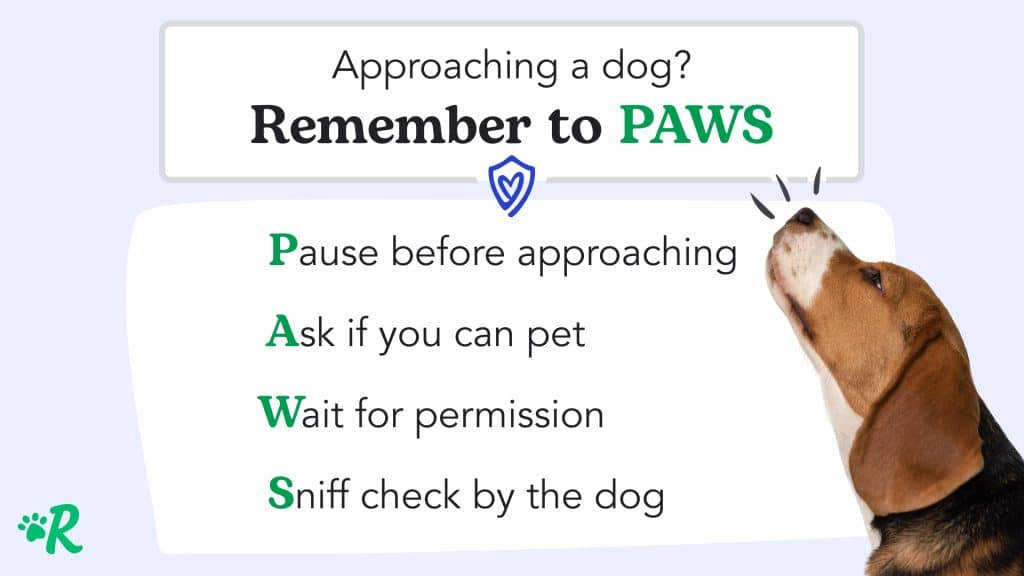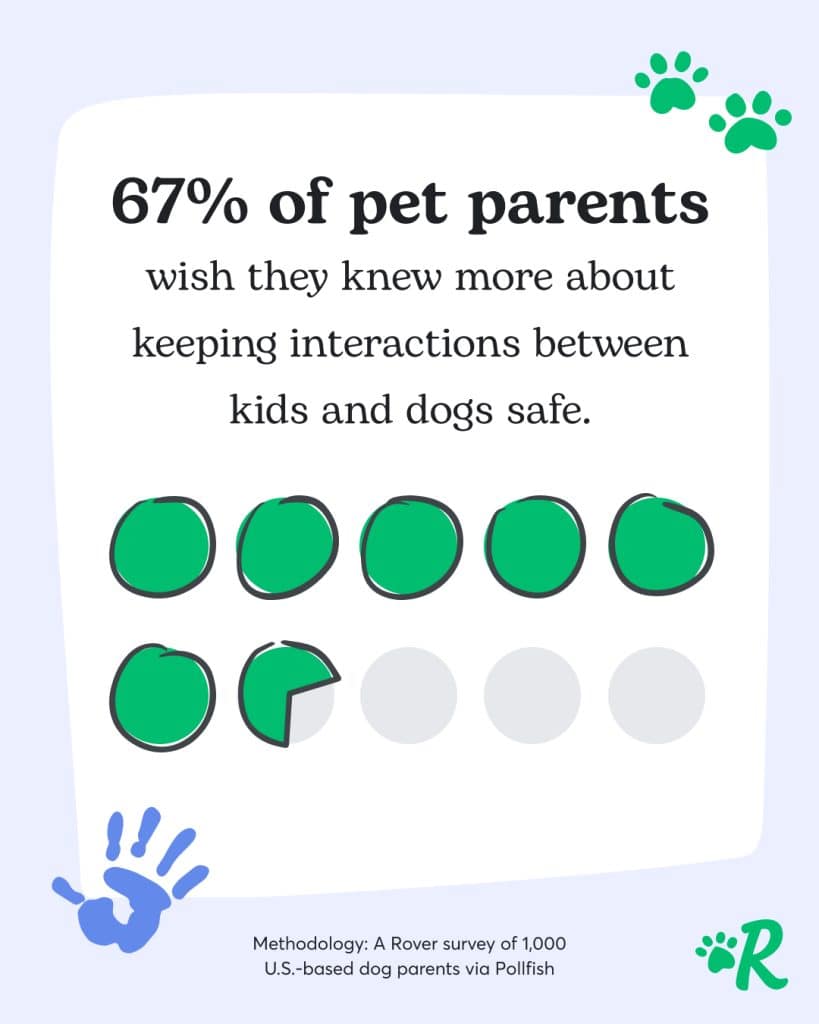- Not a substitute for professional veterinary help.
In a recent survey* by Rover, more than two-thirds (67%) of pet parents said they wish they knew more about how to ensure their dog and children interact safely.
Pet parents with a child or children at home also expressed uncertainty about the best way to allow their child to encounter a stranger’s dog out on a walk, at a park, or in a friend’s home. Roughly half of parents (47%) want to know more about how to teach their child to approach a dog, and half (48%) of parents said they are nervous when their child interacts with a new dog even though nothing bad has happened previously.
The data explains why this is important. According to the American Veterinary Medical Association (AVMA), “more than 4.5 million people are bitten by dogs each year in the United States,” with children being “the most common victims of dog bites [who] are far more likely to be severely injured.”
Every pet is different, and there are a few key rules to always consider before interacting or approaching. To offer a definitive resource on the topic, we spoke with our team of experts, the Dog People Panel, who offered important considerations for families, as well as tips and strategies for easy encounters between pets and kids, such as:
- How to educate your child to “pet politely” and learn dog body language.
- Why it’s important to take the time to supervise all interactions between children and pets.
- How to establish boundaries and teach your child that your pet is an individual.
- Why, and how, to set “family pet rules.”
- What to know, and what to do, before adopting a pet.
Use PAWS to Check in First
After speaking with the professionals, we developed an easy way to think about facilitating safe interactions between pets and kids: “PAWS”:
- Teach the child to pause before approaching a dog or cat.
- Have the child (or child’s guardian) ask for permission to pet the animal.
- Have the child wait for permission from the pet’s guardian. If permission is granted…
- Have the child gently offer a hand for a sniff check by the pet to determine if they are willing to interact.
Read on for more about how to ensure safe and healthy interactions between all members of the family—human and non-human alike!
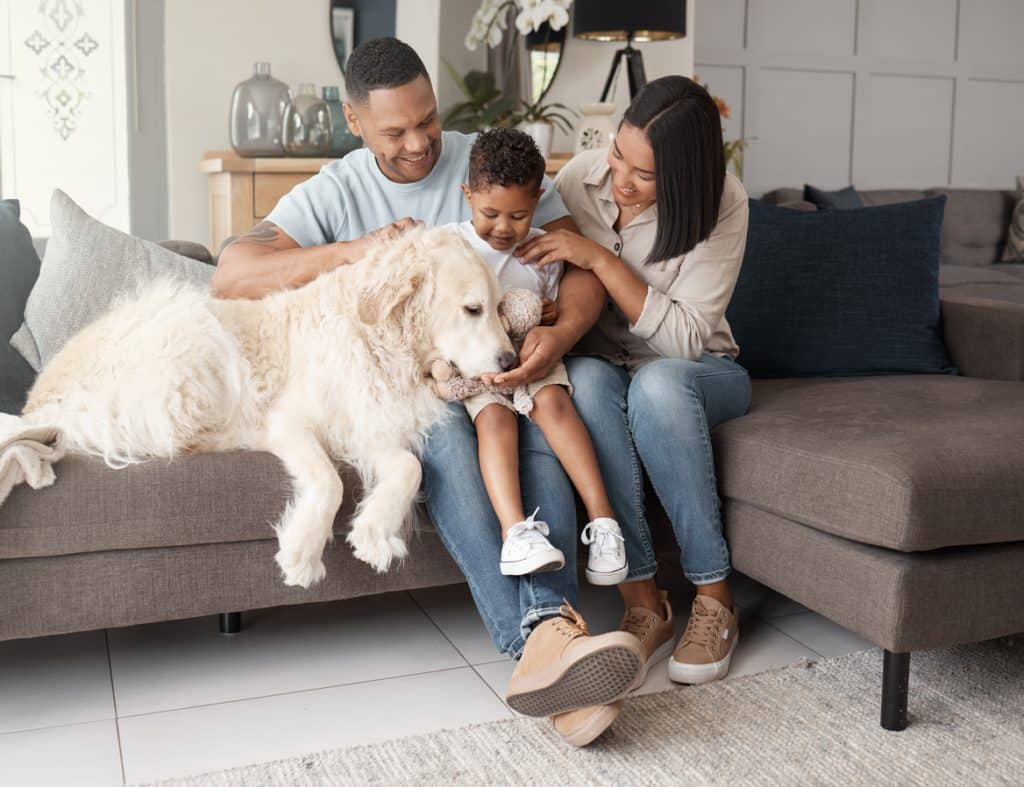
iStock/PeopleImages
Help Your Child Learn Dog Etiquette and Body Language
Dogs have a whole different set of rules of what’s friendly behavior. The best thing you can do is teach your child how to meet the dog on their level. Here are some constructive tips.
- Always ask a dog owner if it’s okay to pet their dog, especially if they’re meeting a dog for the first time. Remember PAWS: Pause, ask, wait, sniff.
- Give dogs space when eating or playing with toys. Remind them they wouldn’t like it much if their sibling came up and stole their snack or their toys.
- Let dogs nap. That way, they’re much less likely to be startled.
- Approach dogs calmly.
- Never scream, run around, pick up the pet, or pull tails or ears. No tugging, squeezing, poking, crawling, leaning or sitting on a pet. These are over-stimulating and frightening for a pet.
- Always “pet politely” (along their back, in the direction their fur grows).
Learn the Warning Signs of Stress, Fear, and Anxiety in Dogs
If a dog is showing any of the behaviors listed below, they’re telling you they feel uncomfortable. Be sensitive to their needs and slowly remove yourself and your kids if you see a dog reacting in any of these ways:
- Whale eye (showing the whites of their eyes)
- Freezing/hunching or rounding of the back
- Avoidance, or trying to remove themselves from the situation
- Cowering under furniture or hiding behind an adult
- Growling, snarling, lunging or bearing teeth
- Lip licking and yawning
- Holding or “pinning” ears
- Flagged tails (tail up at attention) or between their legs
- Raised fur or hackles
Teaching your child how to read and respect a dog’s body language will help ensure they form positive, long-lasting relationships with dogs.
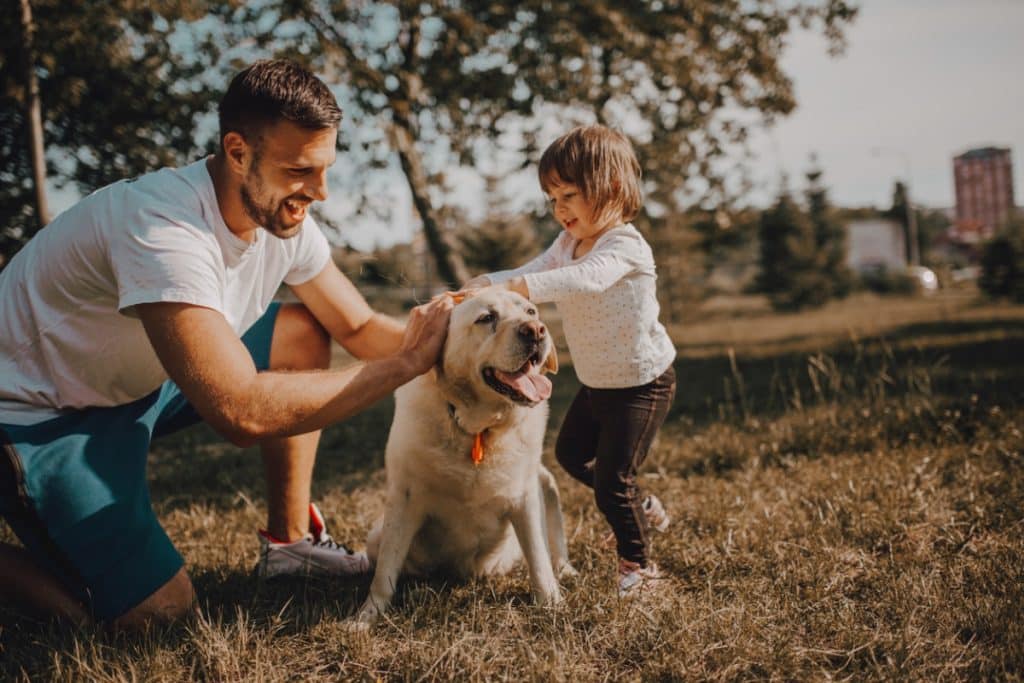
iStock/Nikola Stojadinovic
The Importance of Supervision
Pets aren’t toys, and pets aren’t babysitters. It’s important to remember pets are individuals with their own “opinion, good days and bad days, and things that scare them,” Tedeschi said.
We have been led to believe breeds like Labs or Golden Retrievers are “great family dogs,” Tedeschi said, but “when we stereotype our pets in this way it prevents us from seeing them as individuals.” He notes that, ironically, “Labrador Retrievers are the most common breed for dog bites.”
This is because our idea of our pet, and who our pet really is, can be dramatically different. “Many people will say, ‘I’ve grown up with this type of dog,’ and over-generalize who the dog is [based on what they think they know about the breed],” Tedeschi said. The reality is that, for example, most dogs don’t like to be hugged or crawled on. “It may be cute but animals don’t enjoy this,” emphasized Nicole Ellis, Certified Professional Dog Trainer and Dog People Panelist.
If you aren’t there to advocate for your pet’s needs and interests, especially around toddlers and the very young, even with so-called family-friendly breeds or “socialized” pets, boundaries can be crossed quickly.
Supervision among pets and kids is key.
Supervising Encounters in Public
Whether you are out on a walk with your dog, or with your child in an area where dogs are present, kids will naturally be drawn to animals. So, be a voice for your pet—and teach your child to respect the voice of others speaking for theirs.
If a child wants to approach your dog, let the child know that either: your pet needs their space and doesn’t want attention, or, how you would like the child to initiate contact with your pet. You can say things like, “Let’s see if Fido is interested,” and let your dog take the lead. If your dog is generally approachable, offer constructive direction such as, “she likes gentle pats on the head,” or “he likes gentle scratches on his belly.”
If your child wants to approach a stranger’s dog and it’s OK with you, then ask the child if they think the dog would be interested in saying hello. The dog might be playing with other dogs, or busy eating or sniffing something—these are cues that the dog is fine being left alone. If the dog looks approachable, then accompany your child and seek permission from the dog’s guardian, keeping in mind some pet parents may not be welcoming of an interaction. If they are, ask them how, and where, the dog likes to be touched, always encouraging gentle and calm petting.
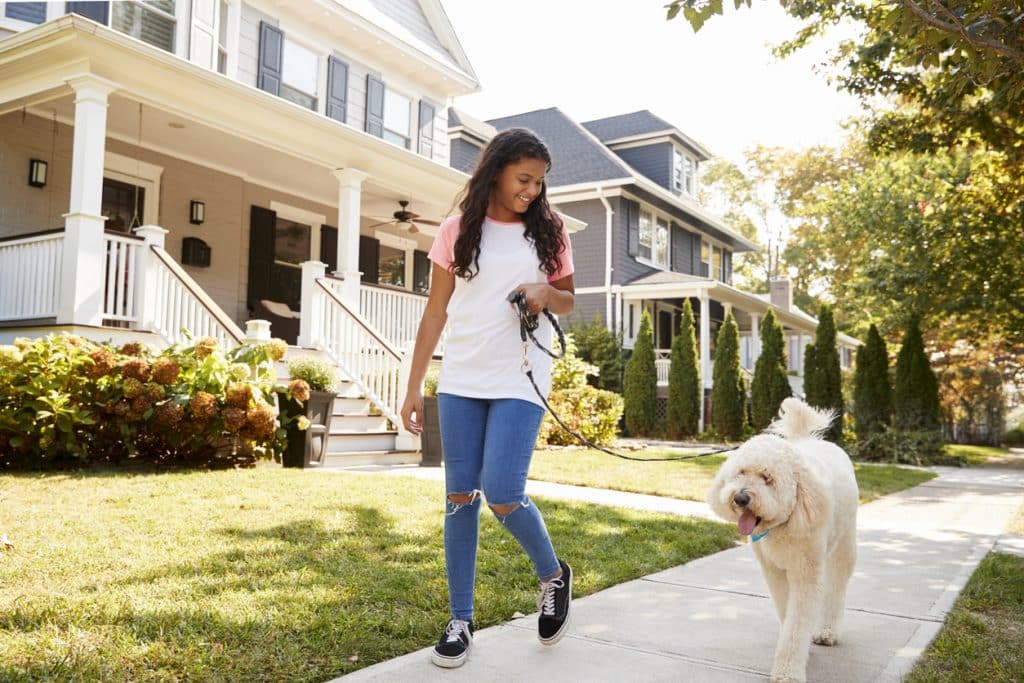
iStock/monkeybusinessimages
Establishing Safety at Home
“There is an assumption that it will all sort itself out,” said Dr. Rebecca Greenstein, Veterinary Expert for Rover’s the Dog People Panel. “But pet parents need to take a proactive role in integrating kids into their pets’ lives safely, and vice versa.” Ultimately it’s the pet parent’s responsibility to ensure everyone is getting along.
Have active conversations with your child about empathy and the behaviors they are observing in their pet. Ask your child to consider things from the pet’s point of view. “When you show a child how the animals appreciate being respected, this is highly reinforcing for young children, and demonstrates healthy relationships,” Tedeschi said. Remind your kids that pets, just like kids, need to have breaks, and their own personal space.
Help older children bond with their dog through supervised play, and on family walks. Ellis said interactive toys such as an iFetch to help create safe boundaries. “The child can put the ball in and the dog can chase the ball, creating safe playtime together.”
Set family “Pet Rules.” This helps reinforce boundaries and acceptable behavior around pets. Consider family policies such as:
- Always ask an adult before touching a stranger’s pet.
- All hands on a pet should be slow and gentle.
- Only pet a dog with one finger (this helps to keep interactions gentle with little hands with developing motor skills).
- Never play around a dog’s food, chew toys, or on the dog’s bed.
- Never force a pet to do anything they don’t want to. If the pet wants to get away, let them.
- Never chase a dog or cat.
- Set play time on and off periods. “You can help kids learn by putting a red bandana on a dog—this means the dog can’t be played with,” said Tedeschi.
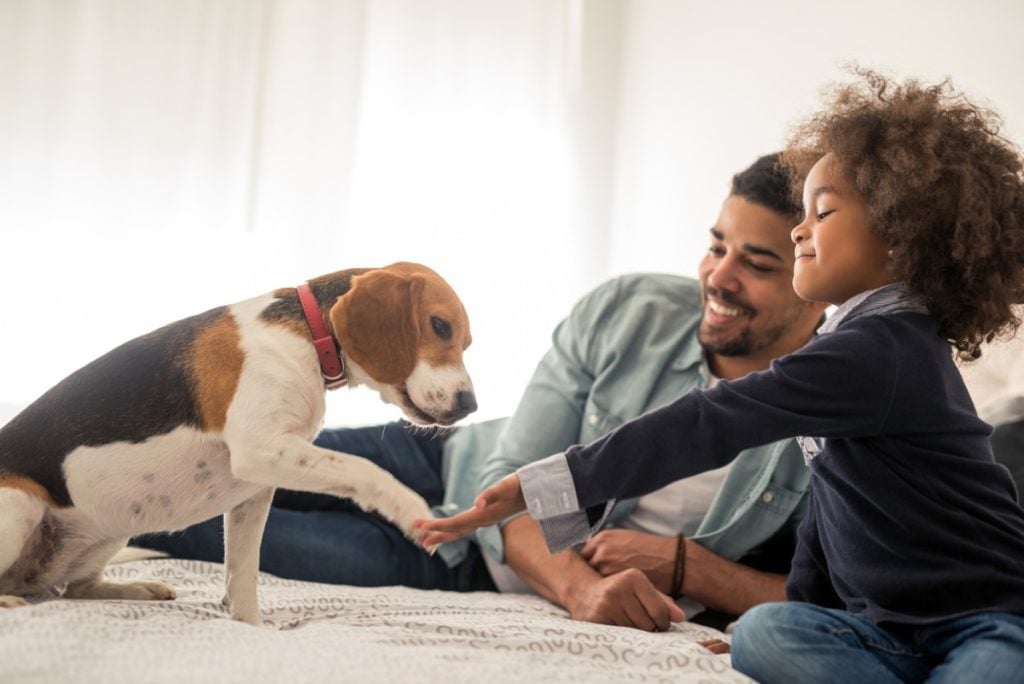
iStock/bernardbodo
Tips for Introducing Your Kid and Dog
A successful first meeting helps to lay the foundation of your family’s journey with your pet. Take time not to rush these first introductions. Establish boundaries as you go, and supervise all interactions.
Consider basic obedience training or puppy classes, Dr. Greenstein said. “It teaches impulse control, sitting, and basic commands that use tools that strengthen the bond you have with your dog.”
If the pet is already part of the family and meeting a new baby, Ellis advised an introduction in an “area the dog is familiar with so they can relax while the new baby is at a distance. You can reward calm behavior, and give the pet a chance to see, hear, and smell the infant.”
With toddlers, all our experts recommend constant supervision. “A dog can very quickly find themselves in a very difficult situation when it’s unsupervised,” Tedeschi said.
If you’re getting a puppy, allow the pup to naturally make their way over to your child when they first meet. This helps the child learn what pet body language looks like when a pet is willing to interact, and establishes the foundation of consenting encounters.
When introducing any new pet to the household, consider the pet’s need for physical space away from the family where they can feel safe if overwhelmed. Offer a safe room or other dedicated space off-limits to kids for the pet to retreat and get acquainted with their new environment. This can be the parents’ bedroom, the pet’s own room, or a crate.

iStock/LightFieldStudios
What to Think About Before Adopting a Dog
To prevent bites and accidents in the first place, it’s critical to do your research before adopting—not after.
“Take an honest inventory of the types of breeds you’re considering, as well as the children in the home,” advised Dr. Greenstein. Ask about the pet’s:
- Age
- Breed
- Health status
- History of rescue
- If they are known to be fear aggressive or possession aggressive
- If they have any medical issues such as arthritis, decreased vision, or back pain
“Recognize the issue of development of the child and the pet,” said Tedeschi. Toddlers with developing motor skills and no impulse control playing near a skittish dog is not a good idea. Turning the lens towards pets, still-learning puppies who don’t know any better may nip or bite a nearby little hand or arm.
Be realistic about your family’s ability to provide the specific type of care an individual pet requires.
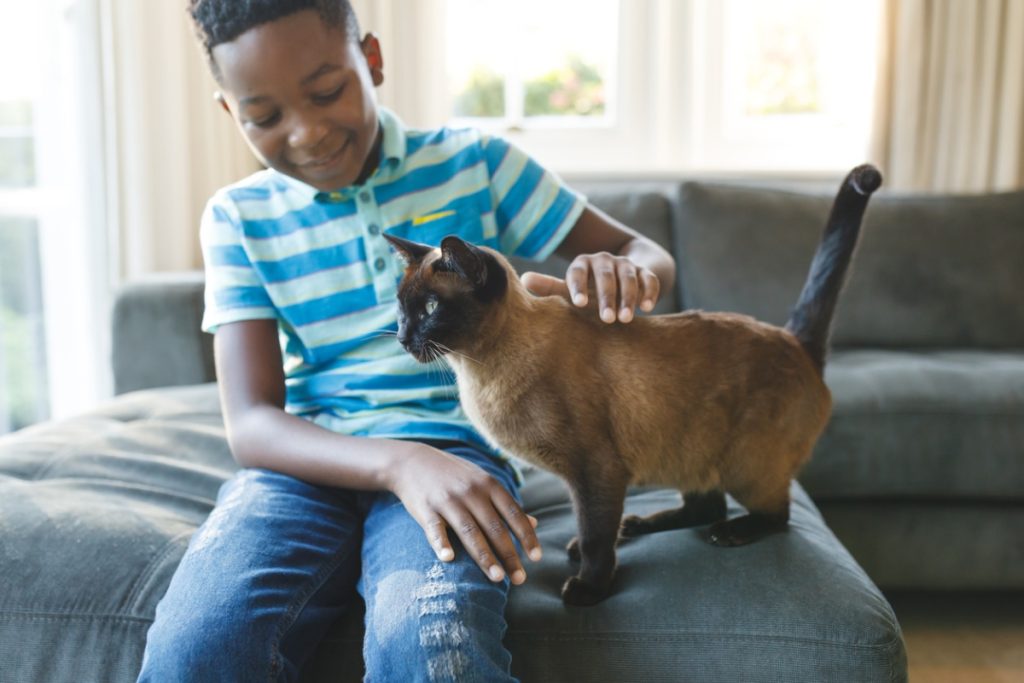
iStock/Wavebreakmedia
What About Cats?
Just like dogs, cats are individuals. There is no specific “family-friendly” breed or type of cat, said Dr. Mikel Delgado, Rover’s resident cat expert.
When introducing a cat or kitten to a household with kids, just as with dogs, “take your time and get to know a cat, and find out any background information about the cat,” Delgado said. Ask questions like, “’Have they been fostered before? Are they comfortable about loud sounds and sudden movement? Do they like being petted? Are they good at coping with stress in their environment?’”
And, as with dogs, modeling pet etiquette and ongoing supervision is key. Here are Delgado’s top 3 takeaways for supervising kids and cats:
- Parents should generally supervise small children around any new pet at first (or until the child is a little older). Kids can offer treats to a cat or play with them gently with a feather wand to build positive associations.
- Demonstrate how to pet a cat, for example, always slowly, gently, and with a flat hand, not with the fingers.
- Cats should have safe spaces that are off limits. When the kitty is in his safe space, everyone leaves him alone. Cats often appreciate having vertical space out of the reach of small children, so a few cat trees or cat shelves are critical for a home with cats and young children. The same is true for the food bowls and litter box, that is kitty’s private time. Cats get overwhelmed with loud noises and a lot of activity, so having some cozy hiding spots in the house where they can retreat, such as the parents’ office or bedroom, can be helpful as well.
The Takeaway
It’s important to understand that safe and healthy relationships between pets and kids don’t just happen on their own. Teaching your child pet etiquette and empathy towards others, establishing boundaries between pets and kids, supervising interactions, setting family pet rules, memorizing the principles of PAWS—Pause, Ask, Wait, Sniff—and doing the necessary pre-adoption research can help set all members of the household, human and non-human alike, up for a lifetime of happy memories together.
*Methodology: A Rover survey of 1,000 U.S.-based dog parents via Pollfish in September 2022.
Additional Resources our Experts Recommend
- Family Paws, a resource for families with pets
- Sophia Yin and low-stress handling training
- The AVMA on Dog Bite Prevention
- What Is My Cat Thinking? by Gwen Bailey
- Doggie Language, by Lili Chin

